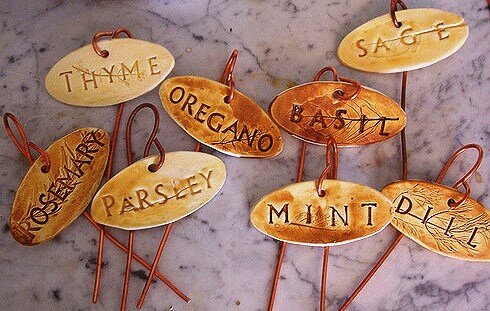Growing Herbs
How to Make an Herb Garden
The no dig method is perfect for growing herbs; just plant straight into your garden, whether they be seedlings, cuttings or perennial clumps that some nice gardener has given you.

Because of their many uses, your herb garden should be situated in a sunny spot very near your kitchen.
Then you can simply step out the door and make an ordinary meal into a culinary delight!
However you grow herbs, sometimes you can be confronted with a frighteningly huge crop of some varieties.
There are chillies galore, lemon balm bushes bursting up everywhere, fennel as high as an elephant's thigh and rampant other herbs running amok...
So stop a minute to smell the rosemary, then read on and pop over to some of the links to become an 'erbal expert:
Parsley — Growing Parsley Guide
Spring Onions — Growing Spring Onions or Scallions Guide

Here are some more ideas for growing and using herbs . . .
Growing herbs in containers
If there isn't an obvious handy spot, here's how to grow herbs in containers.Drying herbs
This answers your questions on how to dry your own herbs for year round-use.~~~~
Dear Gardening Reader – Do you need a gift for someone special?
Try Garden Gift Hub for affordable and interesting
nature inspired products.
~~~~
Herb vinegars
Delightful for you or for gifts, follow these easy directions for how to make herb vinegars.Herb spiral
If your garden layout lends itself to this idea, you can build a herb garden as an Herb Spiral. It's very space efficient and caters for the various micro-climates that herbs like.It involves building a vertical spiral, usually from rocks, and a typical size is about 2 metres across and 60-100cm high (6ft x 2-3ft). The top is quite dry and hot; the bottom is moist and there is a sunny side and a shady side. A garden of this size will need about 1.5 cubic metres of soil or compost materials.
The top is good for Mediterranean heat-loving type herbs like rosemary, thyme and sage.
The mid sections suit chives, shallots, Italian parsley, tarragon, rocket and coriander.
The lower, cooler section suits borage, peppermint, pennywort and lemon balm. These are just suggestions as there are many plants that will grow in your spiral.
As you probably know, for gardeners in the Northern hemisphere, the hottest side of your herb spiral will be facing south. For those in the Southern hemisphere, the hottest side of your spiral will be facing north.
Anytime, anywhere is good for growing herbs. Follow the sage advice from old Basil who always says "now's the thyme."
